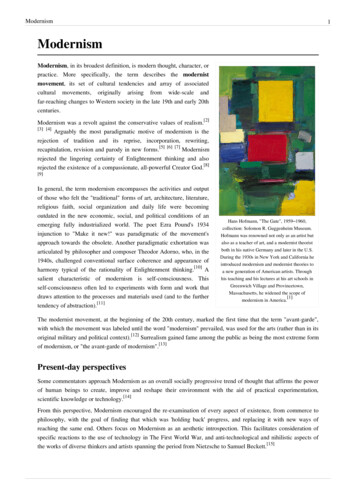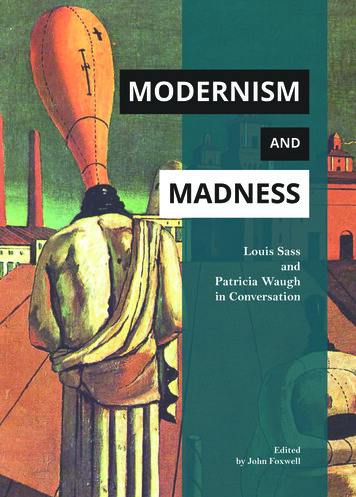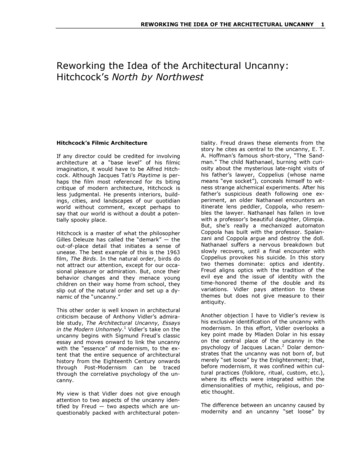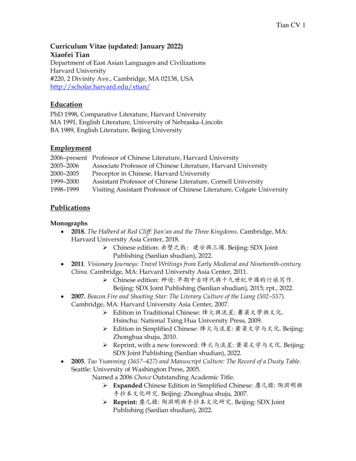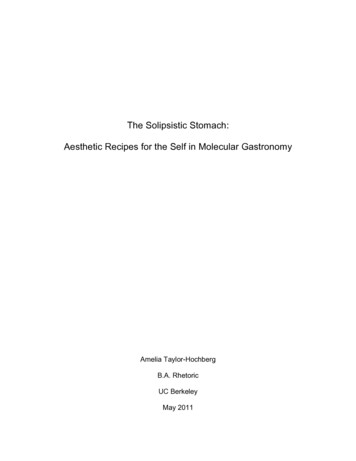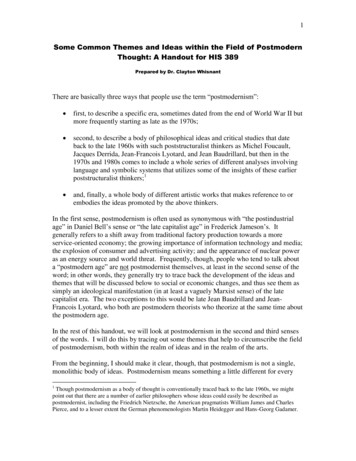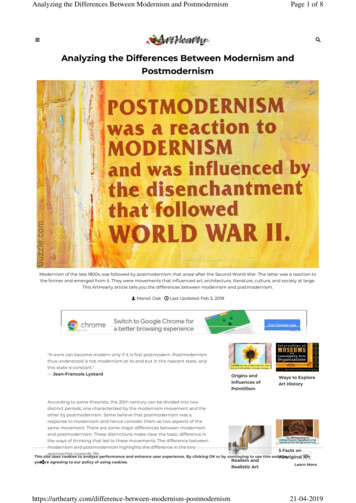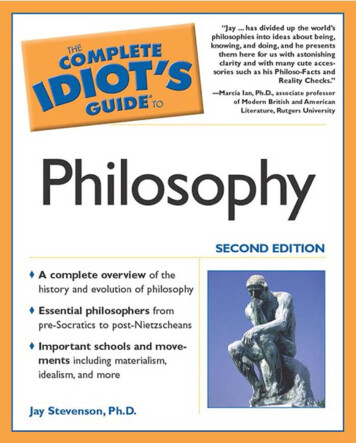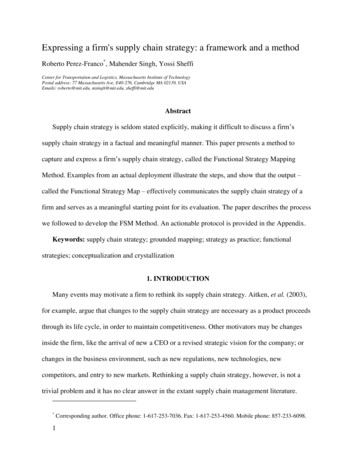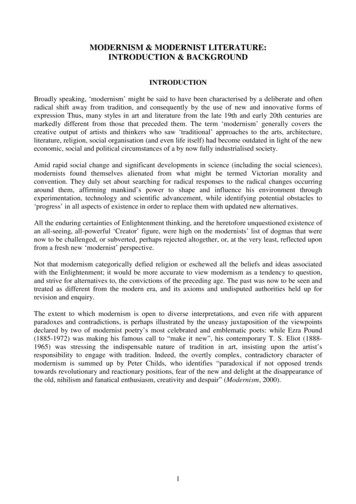
Transcription
MODERNISM & MODERNIST LITERATURE:INTRODUCTION & BACKGROUNDINTRODUCTIONBroadly speaking, ‘modernism’ might be said to have been characterised by a deliberate and oftenradical shift away from tradition, and consequently by the use of new and innovative forms ofexpression Thus, many styles in art and literature from the late 19th and early 20th centuries aremarkedly different from those that preceded them. The term ‘modernism’ generally covers thecreative output of artists and thinkers who saw ‘traditional’ approaches to the arts, architecture,literature, religion, social organisation (and even life itself) had become outdated in light of the neweconomic, social and political circumstances of a by now fully industrialised society.Amid rapid social change and significant developments in science (including the social sciences),modernists found themselves alienated from what might be termed Victorian morality andconvention. They duly set about searching for radical responses to the radical changes occurringaround them, affirming mankind’s power to shape and influence his environment throughexperimentation, technology and scientific advancement, while identifying potential obstacles to‘progress’ in all aspects of existence in order to replace them with updated new alternatives.All the enduring certainties of Enlightenment thinking, and the heretofore unquestioned existence ofan all-seeing, all-powerful ‘Creator’ figure, were high on the modernists’ list of dogmas that werenow to be challenged, or subverted, perhaps rejected altogether, or, at the very least, reflected uponfrom a fresh new ‘modernist’ perspective.Not that modernism categorically defied religion or eschewed all the beliefs and ideas associatedwith the Enlightenment; it would be more accurate to view modernism as a tendency to question,and strive for alternatives to, the convictions of the preceding age. The past was now to be seen andtreated as different from the modern era, and its axioms and undisputed authorities held up forrevision and enquiry.The extent to which modernism is open to diverse interpretations, and even rife with apparentparadoxes and contradictions, is perhaps illustrated by the uneasy juxtaposition of the viewpointsdeclared by two of modernist poetry’s most celebrated and emblematic poets: while Ezra Pound(1885-1972) was making his famous call to “make it new”, his contemporary T. S. Eliot (18881965) was stressing the indispensable nature of tradition in art, insisting upon the artist’sresponsibility to engage with tradition. Indeed, the overtly complex, contradictory character ofmodernism is summed up by Peter Childs, who identifies “paradoxical if not opposed trendstowards revolutionary and reactionary positions, fear of the new and delight at the disappearance ofthe old, nihilism and fanatical enthusiasm, creativity and despair” (Modernism, 2000).1
THE ‘EARLY MODERN’ PERIOD‘Early modern’ is a term used by historians to refer to the period approximately from AD 1500 to1800, especially in Western Europe. It follows the Late Medieval period, and is marked by the firstEuropean colonies, the rise of strong centralised governments, and the beginnings of recognisablenation-states that are the direct antecedents of today’s states, in what is called modern times. Thisera spans the two centuries between the Middle Ages and the Industrial Revolution that providedthe basis for modern European and American society, and in subsequent years the term ‘earlymodern has evolved to be less euro-centric, more generally useful for tracking related historicalevents across vast regions, as the cultural influences and dynamics from one region impacting ondistant others has become more appreciated.The early modern period is characterised by the rise of science, the shrinkage of relative distancesthrough improvements in transportation and communications and increasingly rapid technologicalprogress, secularised civic politics and the early authoritarian nation-states. Furthermore, capitalisteconomies and institutions began their rise and development, beginning in northern Italian republicssuch as Genoa, and the Venetian oligarchy. The early modern period also saw the rise of theeconomic theory of mercantilism. As such, the early modern period represents the decline andeventual disappearance, in much of the European sphere, of Christian theocracy, feudalism andserfdom. The period includes the Reformation, the disastrous Thirty Years’ War (1618-48), whichis generally considered one of the most destructive conflicts in European history, in addition to theCommercial Revolution, the European colonisation of the Americas, the Golden Age of Piracy andthe peak of the European witch-hunt craze.The expression ‘early modern’ is sometimes (and incorrectly) used as a substitute for the term‘Renaissance’. However, ‘Renaissance’ is properly used in relation to a diverse series of culturaldevelopments that occurred over several hundred years in many different parts of Europe –especially central and northern Italy – and spans the transition from late medieval civilization to theopening of the ‘early modern’ period.Artistically, the Renaissance is clearly distinct from what came later, and only in the study ofliterature is the early modern period considered broadly as a standard: music, for instance, isgenerally divided between Renaissance and Baroque; similarly, philosophy is divided betweenRenaissance philosophy and the Enlightenment. In other fields, perhaps, there is more continuitythrough the period, as can be seen in the contexts of warfare and science.Adapted from: http://en.wikipedia.org2
THE ‘MODERN’ PERIODThe modern period (known also as the ‘modern era’, or also ‘modern times’) is the period of historythat succeeded the Middle Ages (which ended in approximately 1500 AD) As a historical term, it isapplied primarily to European and Western history.The modern era is further divided as follows:* The ‘early period’, outlined above, which concluded with the advent of the Industrial Revolutionin the mid 18th century.* The 18th century Enlightenment, and the Industrial Revolution in Britain, can be posited amid thedawning of an ‘Age of Revolutions’, beginning with those in America and France, and thenpushed forward in other countries partly as a result of the upheavals of the Napoleonic Wars.* Our present or contemporary era begins with the end of these revolutions in the 19th century, andincludes World War I, World War II, and the Cold War.The modern period has been a period of significant development in the fields of science, politics,warfare, and technology. It has also been an age of discovery and globalisation: it is during this timethat the European powers and later their colonies, began their political, economic, and culturalcolonisation of the rest of the world.By the late 19th and early 20th century, modernist art, politics, science and culture had come todominate not only Western Europe and North America, but almost every civilised area on the globe,including movements thought of as opposed to the West and globalisation. The modern era isclosely associated with the development of individualism, capitalism, urbanisation and a belief inthe positive possibilities of technological and political progress.The brutal wars and other problems of this era, many of which come from the effects of rapidchange and the connected loss of strength of traditional religious and ethical norms, have led tomany reactions against modern development: optimism and belief in constant progress has beenmost recently criticised by ‘postmodernism’, while the dominance of Western Europe and NorthAmerica over other continents has been criticised by postcolonial theory.The concept of the modern world as distinct from an ancient or medieval one rests on a sense that‘modernity’ is not just another era in history, but rather the result of a new type of change. This isusually conceived of as progress driven by deliberate human efforts to better their situation.Advances in all areas of human activity – politics, industry, society, economics, commerce,transport, communication, mechanisation, automation, science, medicine, technology, and culture –appear to have transformed an ‘old world’ into the ‘modern’ or ‘new world’. In each case, theidentification of the old Revolutionary change can be used to demarcate the old and old-fashionedfrom the modern.Much of the modern world has replaced the Biblical-oriented value system, re-evaluated themonarchical government system, and abolished the feudal economic system, with new democraticand liberal ideas in the areas of politics, science, psychology, sociology, and economics.Adapted from: http://en.wikipedia.org3
MODERNISMThe first half of the nineteenth century saw an aesthetic turning away from the realities of politicaland social fragmentation, and so facilitated a trend towards Romanticism: emphasis on individualsubjective experience, the sublime, the supremacy of Nature as a subject for art, revolutionary orradical extensions of expression, and individual liberty. By mid-century, however, a synthesis ofthese ideas with stable governing forms had emerged, partly in reaction to the failed Romantic anddemocratic Revolutions of 1848. Exemplified by ‘practical’ philosophical ideas such as positivism,and called by various names – in Great Britain it is designated the ‘Victorian era’ – this stabilizingsynthesis was rooted in the idea that reality dominates over subjective impressions.Central to this synthesis were common assumptions and institutional frames of reference, includingthe religious norms found in Christianity, scientific norms found in classical physics and doctrinesthat asserted that the depiction of external reality from an objective standpoint was not only possiblebut desirable. Cultural critics and historians label this set of doctrines Realism, though this term isnot universal. In philosophy, the rationalist, materialist and positivist movements established aprimacy of reason and system.Against this current ran a series of ideas, some of them direct continuations of Romantic schools ofthought. Notable among these were the agrarian and revivalist movements in plastic arts and poetry(e.g. the Pre-Raphaelite Brotherhood and the philosopher John Ruskin). Rationalism also drewresponses from the anti-rationalists in philosophy: in particular, G. W. F. Hegel’s dialectic view ofcivilization and history drew responses from Friedrich Nietzsche and Søren Kierkegaard, who wereL to R: Hegel; Kierkegaard; Nietzsche; Ruskinmajor influences on Existentialism. All of these separate reactions together began to be seen asoffering a challenge to any comfortable ideas of certainty derived by civilization, history, or purereason.From the 1870s onward, the ideas that history and civilization were inherently progressive and thatprogress was always good came under increasing attack. The likes of the German composer RichardWagner (1813-83) and the Norwegian dramatist Henrik Ibsen (1828-1906) had been reviled fortheir own critiques of contemporary civilization and for their warnings that accelerating ‘progress’would lead to the creation of individuals detached from social values and isolated from their fellowmen. Arguments arose that the values of the artist and those of society were not merely different,but that Society was antithetical to Progress, and could not move forward in its present form.Philosophers called into question the previous optimism. The work of the German philosopherArthur Schopenhauer (1788-1860) was labelled ‘pessimistic’ for its idea of the ‘negation of thewill’, an idea that would be both rejected and incorporated by later thinkers such as Nietzsche(1844-1900).4
Two of the most significant thinkers of the period were, in biology, Charles Darwin, and in politicalscience, Karl Marx. Darwin’s theory of evolution by natural selection undermined the religiouscertainty of the general public, and the sense of human uniqueness of the intelligentsia. The notionthat human beings were driven by the same impulses as ‘lower animals’ proved to be difficult toreconcile with the idea of an ennobling spirituality. Marx argued there were fundamentalcontradictions within the capitalist system – and that, contrary to the libertarian ideal, the workerswere anything but free. Both thinkers would spawn defenders and schools of thought that wouldbecome decisive in establishing modernism.Separately, in the arts and letters, two ideas originating in France would have particular impact. Thefirst was Impressionism, a school of painting that initially focused on work done, not in studios, butoutdoors. Impressionist paintings demonstrated that human beings do not see objects, but insteadsee light itself. The school gathered adherents despite internal divisions among its leadingpractitioners, and became increasingly influential. Initially rejected by the most importantcommercial show of the time, the government-sponsored Paris Salon, the Impressionists organisedyearly group exhibitions in commercial venues during the 1870s and 1880s, timing them to coincidewith the official Salon. A significant event of 1863 was the Salon des Refusés, created by EmperorNapoleon III to display all of the paintings rejected by the Paris Salon. While most were in standardThe Luncheon on the Grass, by Édouard Manet (1862-63)styles, but by inferior artists, the work of Manet attracted tremendous attention, and openedcommercial doors to the movement.The second school was Symbolism, marked by a belief that language is expressly symbolic in itsnature, and that poetry and writing should follow connections that the sound and texture of thewords create. The poet Stéphane Mallarmé would be of particular importance to what would occurafterwards.At the same time social, political, and economic forces were at work that would become the basis toargue for a radically different kind of art and thinking. Chief among these was steam-poweredindustrialization, which produced buildings that combined art and engineering in new industrialmaterials such as cast iron to produce railroad bridges and glass-and-iron train sheds – or the EiffelTower, which broke all previous limitations on how tall man-made objects could be – and at thesame time offered a radically different environment in urban life.5
The miseries of industrial urbanism, and the possibilities created by scientific examination ofsubjects, brought changes that would shake a European civilization which had, until then, regardeditself as having a continuous and progressive line of development from the Renaissance. With thetelegraph offering instant communication at a distance, the experience of time itself was altered.In the 1890s a strand of thinking began to assert that it was necessary to push aside previous normsentirely, instead of merely revising past knowledge in light of current techniques. It was argued that,if the nature of reality itself was in question, and if restrictions which had been in place aroundhuman activity were falling, then art, too, would have to radically change. Thus, in the first fifteenyears of the twentieth century a series of writers, thinkers, and artists made the break withtraditional means of organising literature, painting, and music. This wave of the modern movementbroke with the past in the first decade of the twentieth century, and tried to redefine various artforms in a radical manner.Composers such as Schoenberg, Stravinsky, and George Antheil represent modernism in music.Artists such as Gustav Klimt, Picasso, Matisse, Mondrian, and the movements Les Fauves, CubismWoman with a Hat, by Henri Matisse (1905)and the Surrealists represent various strains of Modernism in the visual arts, while architects anddesigners such as Le Corbusier, Walter Gropius, and Ludwig Mies van der Rohe brought modernistideas into everyday urban life. Several figures outside of artistic modernism were influenced byartistic ideas; for example, John Maynard Keynes was friends with Virginia Woolf and other writersof the London-based Bloomsbury group.On the eve of the First World War a growing tension and unease with the social order, seen in theRussian Revolution of 1905 and the agitation of ‘radical’ parties, also manifested itself in artisticworks in every medium, which radically simplified or rejected previous practice. In 1913 – the yearof Edmund Husserl’s Ideas, Ezra Pound’s founding of Imagism, and the New York Armory Show –Stravinsky (1882-1971) composed The Rite of Spring for a ballet, choreographed by VaslavNijinsky, that depicted human sacrifice. Meanwhile, young painters such as Picasso and Matissewere causing a shock with their rejection of traditional perspective as the means of structuringpaintings.These developments began to give a new meaning to what was termed ‘Modernism’: it nowembraced disruption, rejecting or moving beyond simple Realism in literature and art, and rejectingor dramatically altering tonality in music. This set modernists apart from 19th century artists, whohad tended to believe in 'progress'. Writers like Dickens and Tolstoy, painters like Turner, and6
musicians like Brahms were not ‘radicals’ or ‘Bohemians’, but were instead valued members ofsociety who produced art that added to society, even if it were, at times, critiquing less desirableaspects of it. Modernism, while it was still progressive, increasingly saw traditional forms andtraditional social arrangements as hindering progress, and therefore the artist was recast as arevolutionary, overthrowing rather than enlightening.Modernist philosophy and art were still viewed as being part, and only a part, of the larger socialmovement. Artists such as Klimt and Cézanne, and composers like Mahler and Richard Strausswere ‘the terrible moderns’ – those farther to the avant-garde were more heard of than heard.Polemics in favour of geometric or purely abstract painting were largely confined to ‘littlemagazines’ (like The New Age in the UK) with tiny circulations. Modernist primitivism andpessimism were controversial, but were not seen as representative of the Edwardian mainstream,which was more inclined towards a Victorian faith in progress and liberal optimism.However, the Great War and its subsequent events were the cataclysmic upheavals that late 19thcentury artists had been worrying about: firstly, the failure of the previous status quo seemed selfevident to a generation that had seen millions die fighting over scraps of earth – prior to the war, ithad been argued that no one would fight such a war, since the cost was too high; secondly, the birthof a machine age changed the conditions of life and, finally, the immensely traumatic nature of theexperience dashed basic assumptions – Realism seemed to be bankrupt when faced with thefundamentally fantastic nature of trench warfare, as exemplified by books such as Erich MariaRemarque’s All Quiet on the Western Front. Moreover, the view that mankind was making slowand steady moral progress came to seem ridiculous in the face of the senseless slaughter of the War.The First World War, at once, fused the harshly mechanical geometric rationality of technologywith the nightmarish irrationality of myth.Thus in the 1920s, modernism, which had been such a minority taste before the war, came to definethe age, and was seen in Europe in such critical movements as Dada, and then in constructivemovements such as Surrealism, as well as in smaller movements such as the Bloomsbury Group.Each of these ‘modernisms’, as some observers labelled them at the time, stressed new methods toproduce new results. Again, Impressionism was a precursor: breaking with the idea of nationalschools, artists and writers adopted ideas of international movements. Surrealism, Cubism,Bauhaus, and Leninism are all examples of movements that rapidly found adopters far beyond theiroriginal geographic base.7
Exhibitions, theatre, cinema, books and buildings all served to cement the public perception that theworld was changing. Hostile reaction often followed, as paintings were spat upon, riots wereorganised at the opening of works, and political figures denounced modernism as unwholesome andimmoral. At the same time, the 1920s were known as the ‘Jazz Age’, and the public showedconsiderable enthusiasm for cars, air travel, the telephone, and other technological advances.While some writers attacked the madness of the new modernism, others described it as soulless andmechanistic. But nevertheless, by 1930, modernism had won a place in the establishment, includingthe political and artistic establishment, although by this time modernism itself had changed. Therewas a general reaction in the 1920s against the pre-1918 modernism, which had emphasized itscontinuity with a past while rebelling against it, and against the aspects of that period which seemedexcessively mannered, irrational, and emotionalistic.Modernism had by this stage entered popular culture, too. With the increasing urbanization ofpopulations, it was beginning to be looked to as the source for ideas to deal with the challenges ofthe day. Popular culture, which was not derived from high culture but instead from its own realities(particularly mass production) fuelled much modernist innovation. Modern ideas in art appeared incommercials and logos, the famous London Underground logo, designed by Edward Johnston (seeabove), being an early example of the need for clear, easily recognizable and memorable visualsymbols.One of the most visible changes of this period, in fact, is the adoption of objects of modernproduction into daily life. Electricity, the telephone, the motorcar – and the need to work with them,repair them and live with them – created the need for new forms of manners, and social life. Thekind of disruptive moment which only a few knew in the 1880s, had by now become a commonoccurrence.Many modernists believed that by rejecting tradition they could discover radically new ways ofmaking art. Arnold Schoenberg believed that by rejecting traditional tonal harmony, the hierarchicalsystem of organising works of music which had guided music-making for at least a century and ahalf, he had discovered a wholly new way of organising sound. Abstract artists, taking as theirexamples the Impressionists, as well as Paul Cézanne and Edvard Munch, began with theassumption that colour and shape formed the essential characteristics of art, not the depiction of thenatural world. Kandinsky, Mondrian, and Malevich all believed in redefining art as the arrangementof pure colour. The use of photography, which had rendered much of the representational function8
of visual art obsolete, strongly affected this aspect of modernism. However, these artists alsobelieved that by rejecting the depiction of material objects they helped art move from a materialistto a spiritualist phase of development.Other modernists, especially those involved in design, had more pragmatic views. Modernistarchitects and designers believed that new technology rendered old styles of building obsolete. LeCorbusier thought that buildings should function as ‘machines for living in’, analogous to cars,which he saw as machines for travelling in. Just as cars had replaced horses, so modernist designshould reject the old styles and structures inherited from Ancient Greece or from the Middle Ages.In same cases form superseded function and, following this machine aesthetic, modernist designerstypically rejected decorative motifs in design, preferring to emphasise the materials used and puregeometrical forms. The skyscraper, such as Mies van der Rohe’s 1950s Seagram Building in NewYork, became the archetypal modernist building. Modernist design of houses and furniture alsotypically emphasized simplicity and clarity of form, open-plan interiors, and the absence of clutter.Many aspects of modernist design still persist within the mainstream of contemporary architecturetoday, though its previous dogmatism has given way to a more playful use of decoration, historicalquotation, and spatial drama.In other arts such pragmatic considerations were less important. In literature and visual art somemodernists sought to defy expectations mainly in order to make their art more vivid, or to force theaudience to question their own preconceptions. This aspect of modernism has often seemed areaction against consumer culture, which developed in Europe and North America in the late 19thcentury. Whereas most manufacturers would try to make products that will be marketable byappealing to preferences and prejudices, high modernists rejected such consumerist attitudes inorder to undermine conventional thinking. The art critic Clement Greenberg expounded this theoryof modernism in his essay Avant-Garde and Kitsch, in which he labelled the products of consumerculture ‘kitsch’, because their design aimed simply to have maximum appeal, with any ‘difficult’features removed. For Greenberg, modernism thus formed a reaction against the development ofsuch examples of modern consumer culture as commercial popular music, Hollywood, andadvertising. Greenberg associated this with the revolutionary rejection of capitalism.Some modernists did see themselves as part of a revolutionary culture – one that included politicalrevolution. Others rejected conventional politics as well as artistic conventions, believing that arevolution of political consciousness had greater importance than a change in political structures.Many modernists saw themselves as apolitical. Others, such as T. S. Eliot, rejected mass popularculture from a conservative position. Indeed, one could argue that modernism in literature and artfunctioned to sustain an elite culture that excluded the majority of the population.Adapted from: http://en.wikipedia.org9
MODERNIST LITERATUREModernism as a literary movement reached its height in Europe between 1900 and the mid-1920s.‘Modernist’ literature addressed aesthetic problems similar to those examined in non-literary formsof contemporaneous Modernist art, such as painting. Gertrude Stein’s abstract writings, forexample, have often been compared to the fragmentary and multi-perspectival Cubism of her friendPablo Picasso. The general thematic concerns of Modernist literature are well-summarised by thesociologist Georg Simmel: “The deepest problems of modern life derive from the claim of theindividual to preserve the autonomy and individuality of his existence in the face of overwhelmingsocial forces, of historical heritage, of external culture, and of the technique of life” (The Metropolisand Mental Life, 1903).The Modernist emphasis on radical individualism can be seen in the many literary manifestos issuedby various groups within the movement. The concerns expressed by Simmel above are echoed inRichard Huelsenbeck’s First German Dada Manifesto of 1918: “Art in its execution and directionis dependent on the time in which it lives, and artists are creatures of their epoch. The highest artwill be that which in its conscious content presents the thousandfold problems of the day, the artwhich has been visibly shattered by the explosions of last week. The best and most extraordinaryartists will be those who every hour snatch the tatters of their bodies out of the frenzied cataract oflife, who, with bleeding hands and hearts, hold fast to the intelligence of their time.”The cultural history of humanity creates a unique common history that connects previousgenerations with the current generation of humans, and the Modernist re-contextualization of theindividual within the fabric of this received social heritage can be seen in the ‘mythic method’which T.S. Eliot expounded in his discussion of James Joyce’s Ulysses: “In using the myth, inmanipulating a continuous parallel between contemporaneity and antiquity, Mr. Joyce is pursuing amethod which others must pursue after him . It is simply a way of controlling, of ordering, ofgiving a shape and a significance to the immense panorama of futility and anarchy which iscontemporary history” (Ulysses, Order and Myth, 1923).Modernist literature involved such authors as Knut Hamsun (whose novel Hunger (1890) isconsidered to be the first ‘modernist’ novel), Virginia Woolf, T. S. Eliot, Gertrude Stein, H.D.(Hilda Doolittle), Dylan Thomas, Paul Laurence Dunbar, Ezra Pound, Mina Loy, James Joyce,Hugh MacDiarmid, William Faulkner, Jean Toomer, Ernest Hemingway, Rainer Maria Rilke, FranzKafka, Robert Musil, Joseph Conrad, Andrei Bely, W. B. Yeats, F. Scott Fitzgerald, LuigiPirandello, D. H. Lawrence, Katherine Mansfield, Jaroslav Hašek, Samuel Beckett, Menno terBraak, Marcel Proust, Mikhail Bulgakov, Robert Frost, Boris Pasternak, Djuna Barnes, and others.L to R: Samuel Beckett; Ezra Pound (by Wyndham Lewis, 1939); Dylan Thomas; Virginia Woolf.Modernist literature attempted to move from the bonds of Realist literature and to introduceconcepts such as disjointed timelines. Modernism was distinguished by an emancipatorymetanarrative. In the wake of Modernism, and post-enlightenment, metanarratives tended to be10
emancipatory, whereas beforehand this was not a consistent characteristic. Contemporarymetanarratives were becoming less relevant in light of the implications of World War I, the rise oftrade unionism, a general social discontent, and the emergence of psychoanalysis. The consequentneed for a unifying function brought about a growth in the political importance of culture.Modernist literature can be viewed largely in terms of its formal, stylistic and semantic movementaway from Romanticism, examining subject matter that is traditionally mundane – a prime examplebeing The Love Song of J. Alfred Prufrock by T. S. Eliot (1915). Modernist literature often featuresa marked pessimism, a clear rejection of the optimism apparent in Victorian literature in favour ofportraying alienated or dysfunctional individuals within a pr
literature is the early modern period considered broadly as a standard: music, for instance, is generally divided between Renaissance and Baroque; similarly, philosophy is divided between Renaissance philosophy and the Enlighte
